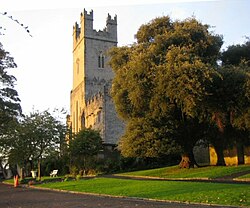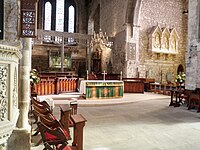St Mary's Cathedral, Limerick
| St Mary's Cathedral | |
|
The Cathedral Church of | |
|---|---|
|
Limerick, County Limerick | |
| Status: | Cathedral |
 St Mary's Cathedral, Limerick | |
| Church of Ireland | |
| Diocese of Tuam, Limerick and Killaloe | |
| Location | |
| Grid reference: | R57885761 |
| Location: | 52°40’6"N, 8°37’24"W |
| Address: | Bridge Street |
| History | |
| Built From 1168 | |
| Gothic | |
| Information | |
| Website: | cathedral.limerick.anglican.org |
The Cathedral Church of the Blessed Virgin Mary, Limerick, otherwise known as Limerick Cathedral or Saint Mary's Cathedral, is a cathedral of the Church of Ireland in the City of Limerick, in County Limerick. It was formerly the cathedral of the Diocese of Limerick, Ardfert and Aghadoe, then of the United Dioceses of Limerick and Killaloe, and is now one of the cathedrals of the Diocese of Tuam, Limerick and Killaloe.
Contents
From the foundation to the Irish Reformation
Limerick Cathedral was founded in 1168, and is the oldest building in Limerick which is in use.[1] It has the only complete set of misericords left in Ireland.[2]
In 1111, the Synod of Ráth Breasail decided that "Saint Mary's church" would become the cathedral church of the Diocese of Limerick. According to tradition, Domnall Mór Ua Briain, the last King of Munster, founded the present cathedral on the site of his palace on King's Island in 1168.[3] The palace had been built on the site of the Viking meeting place, or "Thingmote" – the Vikings' most westerly European stronghold.[1] This had been the centre of government in the early mediæval Viking city. Parts of the palace may be incorporated into the present structure of the cathedral, most prominently the great west door, which is claimed to have been the original main entrance to the royal palace.[4] The west door is now only used on ceremonial occasions.[5] The bishops of Limerick have for centuries knocked on this door and entered by it as part of their installation ceremony. According to tradition, during the many sieges of Limerick the defenders of the city used the stones around the west door to sharpen their swords and arrows, and the marks they made in the stonework can be seen there today.[5]
The tower of Saint Mary's Cathedral was added in the 14th century. It rises to 120 feet, containing a peal of eight bells, of which six were cast by John Taylor & Co, of Loughborough, and two cast by the Whitechapel Bell Foundry, Middlesex. The tower also contains a stationary service bell, which can be rung from the ground floor.[6]
The last King of Munster, Domnall Mór Ua Briain, was purportedly buried in the cathedral, with the remnants of his stone coffin still visible in the Cathedral chancel. Bishop Cornelius O'Dea is buried alongside several other Bishops of Limerick in what is believed to be an Episcopal vault underneath the chancel itself. Also notable are the Sexton, Barrington, Boyd and Vanderkiste tombs along the south entrance pathway.
From the Irish Reformation to the 19th century
There are five chandeliers which hang from the ceiling. These are only lit on special occasions. The larger three of the five were made in Dublin and presented in 1759 by the Limerick Corporation.[4] The belfry holds a peal of eight bells, six of which were presented by William Yorke, mayor of Limerick, in 1673. An active team of bell ringers travels the country to compete with other campanologists.[1]
Saint Mary's received its organ in 1624, when Bishop Bernard Adams donated one. It has been rebuilt over the centuries and was most recently renovated in 1968 and 2005.
In 1620 the English-born judge Luke Gernon, a resident of Limerick, wrote a flattering description of the cathedral:
"not large, but lightsome, and by the providence of the Bishop fairly beautified within, and as gloriously served with singing and organs".[7]
During the Irish Confederacy Wars, the cathedral was briefly transferred to Roman Catholic hands. The bishop of Limerick, Richard Arthur, was buried in the cathedral in 1646.
In 1651, after Oliver Cromwell's forces captured Limerick, the cathedral was used as a stable by the parliamentary army. This misuse was short lived, but was a similar fate to that suffered by some of the other great cathedrals during the Cromwellian campaign in Ireland.[5] The troops also removed the cathedral's original thirteen-foot Pre-Reformation high altar from the cathedral. This was only reinstated in the 1960s. It is the largest such communion table in the British Isles, carved from a single limestone block.[3] It is used for communion services at major festivals and remains in its historic location in what is now the chapel of the Lady Chapel.
In 1691, the cathedral suffered considerable damage, particularly on the east end, during the Siege of Limerick.[8] After the Treaty of Limerick, King William granted £1,000 towards repairs. There are cannonball from 1691 in the Glentworth Chapel/Saint George|Saint George's Chapel inside.[4]
From the 19th century to the 20th century
In 1968, the Irish Government commissioned two postage stamps to commemorate the cathedral's 800 year anniversary. A picture of one of the stamps is displayed on this page. In 1991, there was a large £2.5 million restoration programme which was completed in 1996 with the excavation and re-laying of the floors as well as the installation of underfloor central heating.[1] Restoration continues today to a lesser degree.
From the 20th century to the 21st century
Today, the cathedral is still used for its original purpose as a place of worship and prayer for everybody. It is also the 3rd biggest tourist attraction in Limerick. It is open to the public every day from 9:00 am to 4:45 pm. For Tourists there is a €5 admission charge upon entry. This money is essential for the upkeep of the building, and without it, the cathedral simply could not function.
The cathedral grounds holds a United Nations Memorial Plaque with the names of all the Irish men who died while serving in the United Nations Peacekeepers.
Outside links
| ("Wikimedia Commons" has material about St Mary's Cathedral, Limerick) |
References
- ↑ 1.0 1.1 1.2 1.3 Harvey, Rev. Patrick and Moloney, Donal. A guide to the Cathedral Church of St. Mary The Virgin, Limerick. Limerick. Print.
- ↑ "St. Mary's Cathedral – Church of Ireland • Churches". 2004-07-23. http://limerickslife.com/st-marys-cathedral/.
- ↑ 3.0 3.1 Talbot, Very Rev. Maurice. Monuments of St. Mary's Cathedral. Print.
- ↑ 4.0 4.1 4.2 Mulvin, Linda. History of the Cathedral of St. Mary's Limerick.
- ↑ 5.0 5.1 5.2 "St. Mary's Cathedral, Limerick | Church of Ireland". http://www.cathedral.limerick.anglican.org/.
- ↑ "Dove Details". https://dove.cccbr.org.uk/detail.php?searchString=lim&Submit=+Go+&page=3&DoveID=LIMERICK.
- ↑ Gernon, Luke A Discourse of Ireland 1620 edited by C.L. Falkiner 1904
- ↑ Day, J.G.F. and Patton, H.E.: 'The Cathedrals of the Church of Ireland' (SPCK, 1932)
| Cathedrals of the Church of Ireland |
|---|
|
Province of Armagh:
Armagh •
Clogher •
Derry •
Downpatrick •
Dromore •
Elphin •
Enniskillen •
Killala •
Kilmore •
Lisburn •
Raphoe •
Sligo •
Tuam •
Belfast
|


